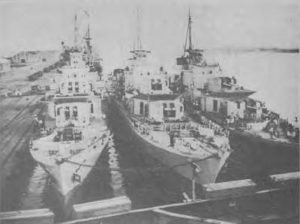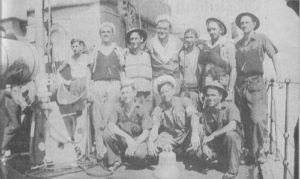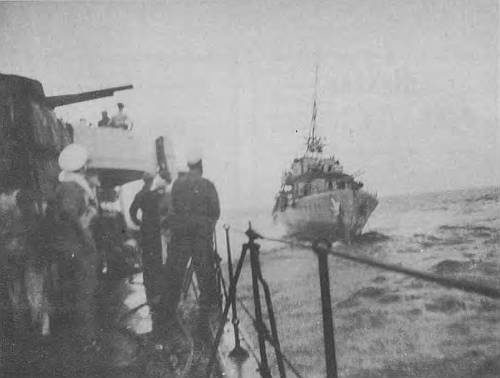- Author
- Lind, L.J. and Payne, Alan
- Subjects
- History - general, Ship histories and stories, WWII operations
- Tags
-
- RAN Ships
- HMAS Warramunga I, HMAS Napier, HMAS Nestor, HMAS Nizam
- Publication
- December 1972 edition of the Naval Historical Review (all rights reserved)

It was not the Luftwaffe, but Nestor herself, which presented the greatest danger to her survival. Petty Officer Les Blackmore recalls:
‘A fresh hazard developed when fire broke out in the uptake of the boilers in No. 1 Boiler Room, the oil bursting into flames as it floated on the water. With no power on the pumps, the ship’s company fought the fire for three hours with Pyrene extinguishers and a chain of buckets. These efforts prevented the fire from spreading, but the localised outbreak grew more intense, and the tell-tale reflection from the funnel was an inviting beacon for enemy aircraft. Coming down from the bridge, Commander Rosenthal looked at the fire through the inspection hole in the funnel and decided that the only prospect of stifling the outbreak was to attempt to suffocate it with hammocks saturated with water. Accordingly, water was poured on to hundreds of hammocks, blankets, etc., and these were dropped in the flames through the inspection holes. More water was poured onto this material and a couple of ratings volunteered to enter the funnel and trample down the bedding. This was done and within an hour the fire was suffocated.‘
Javelin slowly worked up speed to 14½ knots and for a time all went well. The two ships and three Hunt class destroyers sent to escort them home were a target for the German bombers which sensed an easy victim.
The five destroyers threw up a heavy barrage which disconcerted the pilots’ aim. High level bombing was followed by a torpedo bomber attack. The destroyers emerged unscathed from both attacks and to boot, shot down two of the attackers. One of the downed aircraft was credited to Nestor’s guns.
Night brought further troubles to the little fleet. Nestor was yawing badly and the towrope broke twice. The trim was making her unmanageable.
The ships had covered only 80 miles in 10 hours under ideal weather conditions. Alexandria and safety was still 230 miles distant and each one of these miles was dominated by the Luftwaffe.
Time was running out for Nestor. A third tow was passed, but the stricken vessel was yawing even more. Dawn was near and the bombers would return.
The captains of all five ships weighed the situation in their minds. Nestor and the vessel towing her could not survive another day of attack. If the aircraft did not succeed, enemy submarines, who by this time would be alerted to the position, would deal the death blow.
However, it was a third possibility, which with the dawn became a reality, that sealed Nestor’s fate. German E boats were sighted circling the flotilla.

At 0530 on 16th June, Commander Rosenthal requested Javelin to break radio silence and advise the Commander-in-Chief of the gravity of the situation. Fifteen minutes later Javelin relayed Admiral Harwood’s decision to Rosenthal. Nestor was to be scuttled.
The ship’s company was removed and Javelin set about the task of sinking the cripple. Nestor fought to the end. She was as stubborn in dying as she was in living. It took an hour and seven depth charges to send the gallant vessel to her grave.
 In Javelin her crew watched her go. She lay sluggish and heavy in the water, her bows seemingly hanging low like a tired animal. The depth charges mushroomed in a seething turmoil beside her and then, ever so slowly, she turned over, turning her face away before slipping down to her last resting place.
In Javelin her crew watched her go. She lay sluggish and heavy in the water, her bows seemingly hanging low like a tired animal. The depth charges mushroomed in a seething turmoil beside her and then, ever so slowly, she turned over, turning her face away before slipping down to her last resting place.




